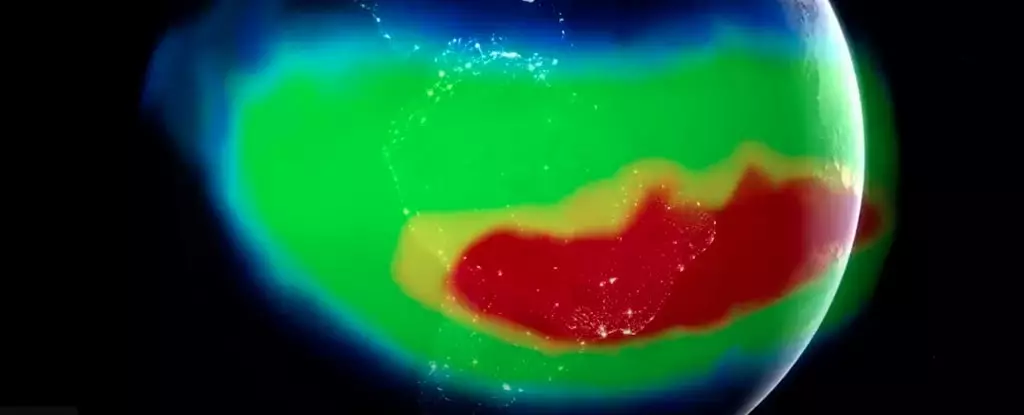In recent years, our understanding of Earth has been profoundly shaped by advancements in space exploration and technology. One of the most captivating phenomena captured by this progress is the South Atlantic Anomaly (SAA), a peculiar region of reduced magnetic intensity located between South America and southwest Africa. NASA has been closely observing this area not just out of curiosity, but because its implications pose considerable risks to our technology and deepen our understanding of geomagnetism. This anomaly, often described as a “dent” or “pothole in space,” serves as a reminder of the complexities underlying our planet’s magnetic field.
The SAA is significant primarily because of its effect on spacecraft and satellites. Unlike life on the Earth’s surface, which remains relatively unaffected by the variations in the magnetic field, satellite technology suffers from exposure to this weakened magnetic barrier. Spacecraft, including the International Space Station (ISS), pass through the anomaly, and the reduced magnetic strength heightens their vulnerability to charged particles emitted by the Sun. This interaction can lead to hardware malfunctions and data loss, compelling operators to implement precautionary shutdowns of satellite systems before traversing the anomaly’s borders.
The Mystery of the Magnetic Field
At the heart of the SAA lies a complex interplay of geological and magnetic forces. Scientists have attributed the anomaly’s creation predominantly to the movement of molten iron within the outer core of the Earth. However, terrain deep below the surface can disrupt this delicate balance. For instance, the African Large Low Shear Velocity Province, a massive reservoir of dense rock located around 2,900 kilometers beneath Africa, might be contributing to the field disturbances we observe today. Researchers emphasize that the SAA may also be linked to changes in the dipole field, where localized magnetic forces exhibit reversed polarity, creating pockets of significantly weakened magnetic intensity.
The work of NASA’s geophysicists, particularly Terry Sabaka and Weijia Kuang, reveals that the SAA is not merely an isolated event but a dynamic and evolving phenomenon. The idea that the region could be characterized by strong localities of reversed magnetic fields offers intriguing insights into how Earth’s magnetic behavior might evolve. The ramifications of these findings extend beyond academic curiosity; understanding the SAA could illuminate broader patterns in magnetic reversals and field stability.
A Journey Through Time
Notably, researchers are beginning to unravel the historical context of the SAA. Initial assumptions painted the anomaly as a novel occurrence, a bizarre quirk of our planet’s magnetic system. However, new studies have emerged suggesting that this magnetic oddity could date back as far as 11 million years. If so, rather than indicating an impending global magnetic field reversal, the SAA may be part of a recurrent cycle—one that has persisted through geological epochs. Such revelations challenge our understanding of geomagnetic dynamics and the longevity of magnetic anomalies on Earth.
Additionally, intriguing findings suggest that the SAA is not static; it appears to be dividing, forming two distinct centers of magnetic intensity. This observation, while not completely understood, has raised questions about the future trajectory of the SAA. Will it continue to split, strengthen, or evolve into something entirely different? As scientists monitor these developments with increasing scrutiny, the South Atlantic Anomaly stands at the precipice of providing substantial insights into our planet’s magnetic behaviors.
The Implications for Space Exploration
As we stand on the brink of space exploration, observing the SAA becomes increasingly critical. The implications of this anomaly extend beyond Earth’s confines; they resonate throughout the realm of space technology and exploration. The SAA’s existing challenges compel scientists and engineers to innovate and adapt, ensuring the safety of future missions while racing to expand humanity’s reach into the cosmos. Continuous monitoring, as noted by NASA researchers, is vital to comprehend the relationship between evolving geomagnetic forces and the safety of technologies that drive exploration.
The SAA is more than just a scientific curiosity; it embodies the delicate balance of forces that govern our planet and beyond. By understanding anomalies like this one, we not only safeguard our technological investments but also deepen our appreciation of Earth’s complex systems—revealing just how interconnected and intricate the fabric of our planet truly is. As we watch these phenomena unfold, we are reminded that our adventures into the cosmos are not merely journeys through space but also explorations of the profound mysteries that lie within our home planet.


Leave a Reply